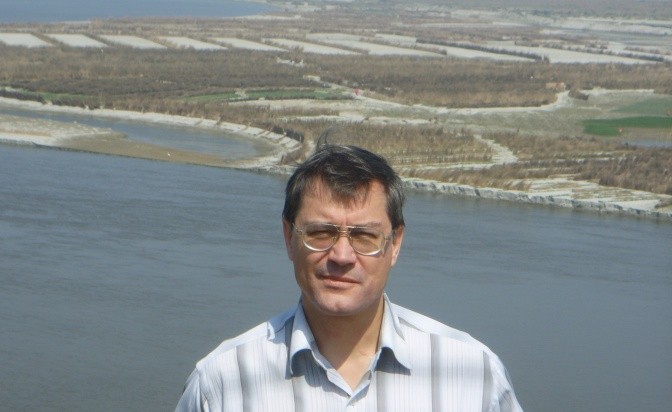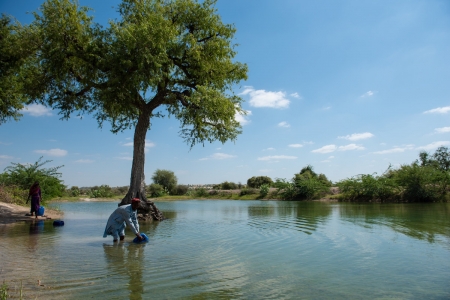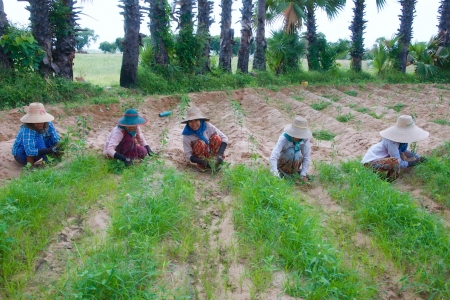This blog is part of WLE’s participation in the conference on “Water in the Anthropocene: Challenges for Science and Governance. Indicators, Thresholds and Uncertainties of the Global Water System“. A series of blogs have been written click here for more information.
Almost 40 years ago, Revelle and Lakshminarayana (1975) coined the term “Ganges Water Machine” trying to find a solution to the fundamental problem of land and water development in the Ganges, where 80% of the monsoon-driven river flow occurs during 4 months from July to October. The dry-season flow of the Ganges in the 1970s was already barely sufficient for irrigation needs of India and Bangladesh, and the pressures have only mounted since then.
Underground storage
Naturally, the idea was that in order to develop its full irrigation potential, it was necessary to store a portion of the monsoon waters for subsequent irrigation use. But because of the steep slopes of the Himalayan foothills and the flatness of the Ganges Plains, surface sites for storage were scarce, and economic efficiency of surface storage was deemed low. Yet, the authors claimed there were great possibilities for underground storage, which should be relatively inexpensive.
They listed several possible ways to store water from the monsoon underground which include:
- increasing infiltration by spreading water in parts of the Ganges basin and constructing bunds at right angles to the flow in uncultivated lands;
- providing space for more groundwater storage by pumping groundwater during the dry season in the vicinity of natural drains, which carry water during the monsoon and along certain tributaries of the Ganges;
- increasing seepage from irrigation canals during the monsoon by extending their network, and subsequently pumping out this seeped water during the dry season, and some others.
Without access to the resource intensive simulations that are available today, the authors estimated the likely increase in irrigation water supplies produced by some of these interventions based on solid hydrodynamics principles. They identified areas of the basin where some of the interventions could be feasible, and assigned a preliminary cost to them.
The “Machine”
The following decades certainly saw the bits and pieces of implementation of this “machine” in India at least. At the regional launch of the CGIAR Research Program on Climate Change for Agriculture and Food Security (CCAFS) in Delhi, some three years ago, Prof Swaminatham spoke of revitalizing the Ganges Water Machine as of one of the most promising water management concepts for India water future. And the recent World Bank Strategic Assessment of the Ganges Basin development (WB, 2012; although seen by some countries as India-centric) still refers to the Ganges Water Machine as the means of delivering flood protection and irrigation benefits for the Basin.
Yet at the workshop on water management in Ganges Plains in Delhi in early April of this year, organized by IWMI and co-sponsored by WLE, CCAFS and ACIAR, surprisingly few people knew what this “water machine” was actually about. And in workshop discussions, a fair question was raised – if this Machine is so-o good, why is it not working, or why is the concept not being consistently pursued? This is not an easy one to answer. But as CGIAR rolls out its new research mega-programs in the region, it may be the time to revisit the whole issue.
In theory or in concept?
There is no doubt in my mind that the concept of being able to tap the under-utilized water of the Ganges Machine is theoretically sound, has enormous development potential and is an excellent tool to communicate the big changes we seek. That said it is hard to grasp the types of technical, social and institutional changes this will require. The Ganges is huge. Leaving most of the typical hydrological numbers aside, just think of the proxies. Some bridges across the Ganges in Bihar are over 7 km long. The Ganges basin’s population is close to double that of the USA. The basin has almost 30% of India’s cultivable land. Imagine some “Machine” working on over 1 mill km2. Got the picture?
While the design of the Machine was done decades ago, the actual “instructions” on how to drive it and what constitutes its progress are still, in fact, to be defined. The instructions should include the scientifically determined targets of groundwater use intensification in various parts of the basin and time horizons by which those can be achieved. And they should include the flood economic damage reduction targets, again with corresponding time horizons.
All these need to be targeted to certain parts of the basin – the Machine will work at the scale of the entire basin only if every country, state and district does its best – and this best will differ a lot spatially. It is hardly possible to store water underground in downstream Bihar and West Bengal at present, for example, aquifers are pretty much full. But it may be possible to do so upstream. Arsenic contamination affects groundwater availability in some parts of the Ganges, but not in others, etc. You need a “bird’s eye”, basin-wide, view of the Machine to make it work.
A sustainable Machine
It is important also to make this Machine sustainable. It can, in fact be a natural perpetuum mobile. You just need to maintain the “filters” in good condition, or change them regularly. There should be safe groundwater and surface water extraction limits and associated environmental water requirements thresholds. These were not considered by the fathers of the Machine at the time, but there is no reason why they shouldn’t be now. It sounds like additional complication, but it really isn’t. Neither is it particularly conflicting with agricultural withdrawals. IWMI, WWF-India and partners' recent work in the upper Ganges suggests that re-allocating enough irrigation canal water to satisfy the scientifically determined environmental and spiritual needs of the river may lead to just 2% of the economic benefits’ loss of crop production, which is easy to fix by improving irrigation efficiency (Amarasinghe et al, 2012).
Powering the Machine: policies and institutions
The most important point perhaps is that we need clear policies and institutional incentives that will power the Machine. Outstanding engineering aspects of the Machine can definitely be fine-tuned and relatively quickly. But the plan that enables the institutional and policy environment needs to be developed and implemented. This is also a big part of the problem that was not considered, at least not explicitly, at the design stage of the Machine.
It is like a car. One thing is to put it together. But driving the car needs a whole set of other enabling factors such as roads, licenses, traffic regulations, insurance, etc. And of course, there is an energy issue - another major problem that needs to be addressed to run the Machine.
The invisible solution
How unique is this idea of the water machine, really? Basically it is all about using underground solutions to manage temporal variability of available water resources. It was quite unique decades ago, when surface storage was thought of as the only solution for flow regulation. Large surface reservoirs are still the dominant thinking worldwide and they indeed have many benefits (and faults).
The World Bank is back with its plans for big dams projects. But why did we not have any major progress with underground solutions so far? Particularly considering that variability increases with changing climate, that rising temperatures increase evaporation losses from surface reservoirs making them progressively less effective, and surface reservoirs are not always “clean” considering the amount of methane they generate – particularly if they are built in tropical forest ecosystems.
Possibly because, amongst other numerous things, nobody ever illustrated – in practice - that underground solution to variability management is competitive, elegant and applicable at the scale of the major river basins of the world. Because, unlike large dams, it is invisible.
But these water machines are effectively operating to this or that extent everywhere in monsoonal climates, but not only in monsoonal ones. IWMI’s recent work in South East Asia (Pavelic et al., 2012) and Central Asia (Karimov et al., 2010) are very clear examples of this. Of course, this is not a silver bullet solution, and there is hardly any such solution in principle. The devil is, as always, in the details. But we should not lose the big picture either. We might start appreciating the idea of managing temporal water resources variability globally through underground solutions, versus, or in addition to surface ones. Whether in the Ganges, or elsewhere. Good ideas, even if they are 40 years old, don’t die. They are sometimes so ahead of their time that they just need time to materialize.
The time is now.
--
References:
AMARASINGHE, U., SMAKHTIN, V., BHARATI, L., RAVINDER, R.S.M. (2012) Reallocating water from canal irrigation for environmental flows: benefits forgone in the Upper Ganga Basin in India. Environment, Development and Sustainability. DOI 10.1007/s10668-012-9385-1
KARIMOV. A., SMAKHTIN, V., MAVLONOV, A, and GRACHEVA, I. (2010) Water ‘banking’ in Fergana valley aquifers—A solution to water allocation in the Syrdarya river basin? Agricultural Water Management, 97: 1461-1468
PAVELIC, P., SRISUK, K., SARAPHIROM, P.,NADEE, S., PHOLKERN, K., CHUSANATHAS, S., MUNYOU, S., TANGSUTTHINON, T., INTARASUT, T., SMAKHTIN, V. (2012) Balancing-out floods and droughts: Opportunities to utilize floodwater harvesting and groundwater storage for agricultural development in Thailand. J. Hydrology 470–471: 55–64
REVELLE, R, AND LAKSHMINARAYANA, V. (1975) The Ganges Water Machine. Science, 188: 611 -616
WORLD BANK (2012) Ganges Strategic Basin Assessment: A Discussion of Regional Opportunities and risks. 143 pp.









Comments
An excellent piece and one that we should seriously consider. The potential impact is enormous both from a food security and poverty alleviation perspective. One of the biggest challenges will be the energy required to drive the 'machine'. Thanks Vladimir for this stimulating article.
Comment originally posted on the Water Governance LinkedIn Group:
I already posted my views in another Group Water Link International.
Nevertheless, I post the same here again. I have no intention to belittle anybody.
I feel happy that this interesting concept which remained dormant for four decades has again become alive. Why it remained dormant for such a long time is not clear to me.
The water situation in the Ganges Basin has been a passion for me, ever since I started my Ph.D. work in IIT, Kanpur during 1970-1975 on 'Estimation of Groundwater Recharge in the Indo-Gangetic Alluvial Plains'. Even now, my recharge estimates are being used by the Central and State Agencies. I vividly recollect those moments when I used to discuss with my very respectable teacher Prof. Lakshminarayana who taught me Hydrology. During the last four decades or so, I have been trying my best to bring together all the stakeholders, for the benefit of a proper management and institutional development of the integral Ganges basin, considering it as a common responsibility.
I am surprised to know from Vladir's article that the participants in the April 2012 conference were ignorant about the GWM concept. Unfortunately I could not attend the conference. During the last four decades, I found even the agriculture experts in India, although, mention on the importance of water in food security, yet, they emphasize more on the biotechnology and GM Products based new crop varieties.
I think GWM concept is quite energy intensive. It would have been worthwhile to implement the concept four decades back. And, now after four decades, when the Ganges Basin has become over-populated, urbanized, industrialized, and so on....., there are many complexities associated with it.
Hence was my views in the previous posting.
Anyway, the time has come that all the good willing stakeholders come forward leaving aside their ego, self interest and benefits, position in their respective organization, or promotion or financial support, honors, recognition or so on.
With your experience and knowledge, I welcome your suggestions on how to go about now for implementation of the GWM concept or other new ideas.
By Prof. Partha Sarathi Datta
This strikes me as an important and exciting "big idea" or "grand challenge" that WLE should take up. But it will require a strong team linking a variety of institutions into a strong partnership, with sufficient resources, flexibility and time to demonstrate the potential convincingly. Work is needed on the demand as well as supply side: in Bihar and West Bengal the aquifer is under-used. It may have implications for the Indus as well. I hope WLE is going to pursue this.